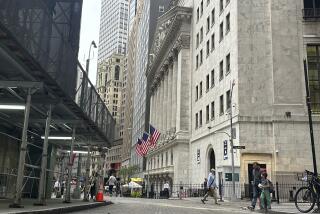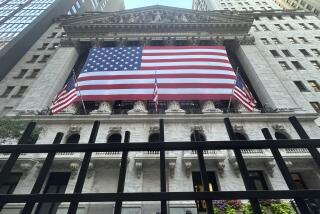Market Watch : Are Gains Presaging Fall?
The Dow Jones industrial average opens this week at a record high--but you’d hardly know it from the confusion and worry in the market.
Just two weeks ago, 3,000 on the Dow seemed a virtual certainty. It still may be: At Friday’s close of 2,935.89, up 7.67 points for the day, the Dow is just a 2.2% rise away from 3,000.
But many big investors feel that stocks have acted very badly over the past two weeks. The market is “just about at the height of internal confusion,” said Ben Zacks, head of Zacks Investment Research in Chicago.
Consider the action in bank and S&L; stocks: They rocketed higher in late May and early June, on expectations that interest rates would fall with a weak economy. Then, early last week, the stocks plunged on new worries about further loan problems. And Friday, the Federal Reserve reported that U.S. industrial production rose 0.6% in May, an unexpectedly strong showing that sent market interest rates sharply higher.
The market is never a picnic to predict, but the sheer momentum that stocks showed in early May was a strong sign of a continuing rally--and indeed it did continue. Now, many analysts believe that the momentum has suddenly dried up after the Dow’s 285-point gain since April 27. Plus, they note that seasonal factors will soon come into play--including second-quarter earnings reports due in July and a bias for technology stocks to drop in the summer.
Robert Bacarella, who manages $130 million at Monetta Financial Services in Wheaton, Ill., charts an index of investor sentiment and technical market data because, as he puts it, “The market is sentiment- and psychology-driven.” His index turned bearish about two weeks ago, Bacarella said.
That doesn’t mean he’s selling everything, he said. “But we are going into a little more defensive position,” selling some of the more volatile stocks that have jumped sharply this year. While the Dow is up 7% year to date, Bacarella says his funds are up 18%, helped by his index’s timely buy signal at the end of January.
Judging the market on sentiment may seem too chancy, but as Bacarella notes, economic indicators have been all over the map this year, and no one can say for sure whether we’re on the verge of a new boom or a recession.
For better or worse, however, economic concerns are likely to heat up over the next few weeks as Wall Street begins to wonder how strong second-quarter corporate earnings will be. If you have any doubt about the importance of those reports, remember that disappointing third- and fourth-quarter earnings reports were largely responsible for the market’s fall and winter slides.
Then, Wall Street was braced for awful first-quarter results, only to find that they weren’t so bad after all: an average 10% decline from a year earlier, according to Zacks’ calculations. That helped fuel the market’s spring surge.
But in recent weeks, analysts have been slowly lowering expectations for second-quarter earnings, Zacks says, to the point where earnings for the S&P; 500 companies now are expected to average 2.8% below year-ago results. Meanwhile, analysts overall have been raising full-year 1990 earnings estimates, Zacks says.
What does that tell you? Wall Street is expecting strong economic growth and a sharp rebound in corporate earnings in the second half of the year. But if second-quarter earnings come in well below expectations, optimism about the rest of the year may disappear. For the stock market, that could be devastating.
A few warning flags were raised on the earnings front last week. Digital Equipment scared a few people when it said European sales were slowing. One of the big supports under the tech-stock rally this year has been strong overseas computer sales.
Even if tech-stock earnings come in as expected in July, Prudential-Bache analyst Rick Martin cautions that the stocks tend to decline in summer months anyway, with a traditional summer computer order slowdown. Investors who track those trends may decide to exit the stocks in the next few weeks to try and beat the expected decline. Any selloff of these market-leading stocks would be another blow to Wall Street’s confidence.
Does all of this mean that it’s time to bail out completely? Veteran investor Albert Nicholas of Nicholas Co. in Milwaukee hardly thinks so. “I could get bearish on the market if I couldn’t find any stocks to buy,” he says. But while the blue chip Dow stocks may be “fully priced or may be overpriced,” Nicholas still sees many depressed stocks worth buying now for the long term.
For the average investor, the best strategy now is a time-honored one: If you’re anxious to get into stocks long term, but fear a short-term plunge, use the “dollar cost averaging” method of investing. Instead of putting, say, $10,000 into stocks now, invest $2,000 now and $2,000 on the same day of each month for the next four months. That way, however the market goes, you’re virtually assured you won’t be putting all of your money in at a short-term top. And if prices drop this summer, you’ll be able to pick up better prices while other investors are taking profits.
SEASONAL DIP DUE?
High-tech stocks have traditionally rallied in the spring, then dropped in the summer as computer orders slow. How some of the stocks performed last spring and summer, peak to trough, how they’ve done since April 30 this year:
May/June July/Aug. May/June Stock 1989 1989 1990 Amdahl +47% -40% +13% Apple +49% -25% -- Compaq +56% -17% +29% Hewlett Packard +15% -13% +9% IBM +9% -7% +10% Silicon Graphics +47% -17% +11% Sun Microsys. +52% -42% +38% Tandem +35% -16% -4% Teradata +48% -20% +10%
Source: Prudential-Bache Securities
More to Read
Inside the business of entertainment
The Wide Shot brings you news, analysis and insights on everything from streaming wars to production — and what it all means for the future.
You may occasionally receive promotional content from the Los Angeles Times.








